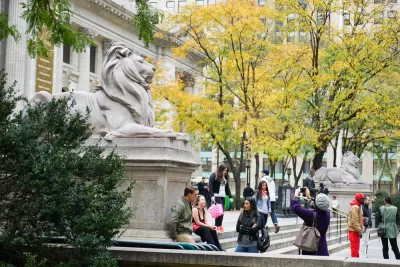More inclusive urban design can help more people access social services and public amenities.

Ishita Gaur describes how urban design can facilitate social services and improve equity in cities. “There are vast inequities in the distribution of healthcare, housing assistance, food accessibility, and educational opportunities, among others. While access to this social infrastructure is to a large extent driven by policy, certain spatial challenges exacerbate the situation—but they don’t have to.”
According to Gaur, “Physical and psychological barriers play a critical role in terms of providing access to vital social services for all. There is a stigma attached to social services, which, often keeps residents from availing of the benefits of such amenities.” Using New York City as an example, Gaur asserts that “The solution lies in creating a network of spaces that New Yorkers can approach for easy and non-judgmental access to the social services they need.”
The city should take this opportunity to not only broaden access to social amenities but also ensure that they are universally inclusive. Designing spaces that are welcoming to people of all income levels, employment statuses, age groups, and gender identities will be key to their success.
Gaur notes that “Inserting social services and amenities inside already welcoming and non-discriminatory spaces can dramatically reduce the perceived barriers that a person might need to overcome in seeking help. New services located at the exterior of these amenities can create a buffer space that receives people while also providing some privacy and anonymity to the individual seeking assistance.” For many people, “Even simple design decisions, such as the presence of a front desk or its location, can dramatically change the experience for an individual.”
As Gaur concludes, creating more inclusive and welcoming public spaces improves the health of cities as a whole. “Creating a healthier city for those most in need leads to a healthier city for all.”
FULL STORY: Op-ed: Social amenities can make space for social equity

Trump Administration Could Effectively End Housing Voucher Program
Federal officials are eyeing major cuts to the Section 8 program that helps millions of low-income households pay rent.

Planetizen Federal Action Tracker
A weekly monitor of how Trump’s orders and actions are impacting planners and planning in America.

The 120 Year Old Tiny Home Villages That Sheltered San Francisco’s Earthquake Refugees
More than a century ago, San Francisco mobilized to house thousands of residents displaced by the 1906 earthquake. Could their strategy offer a model for the present?

Alabama School Forestry Initiative Brings Trees to Schoolyards
Trees can improve physical and mental health for students and commnity members.

NYC Outdoor Dining Could Get a Re-Do
The city council is considering making the al fresco dining program year-round to address cost concerns from small businesses.

HSR Reaches Key Settlement in Northern California City
The state’s high-speed rail authority reached an agreement with Millbrae, a key city on the train’s proposed route to San Francisco.
Urban Design for Planners 1: Software Tools
This six-course series explores essential urban design concepts using open source software and equips planners with the tools they need to participate fully in the urban design process.
Planning for Universal Design
Learn the tools for implementing Universal Design in planning regulations.
Ada County Highway District
Clanton & Associates, Inc.
Jessamine County Fiscal Court
Institute for Housing and Urban Development Studies (IHS)
City of Grandview
Harvard GSD Executive Education
Toledo-Lucas County Plan Commissions
Salt Lake City
NYU Wagner Graduate School of Public Service





























